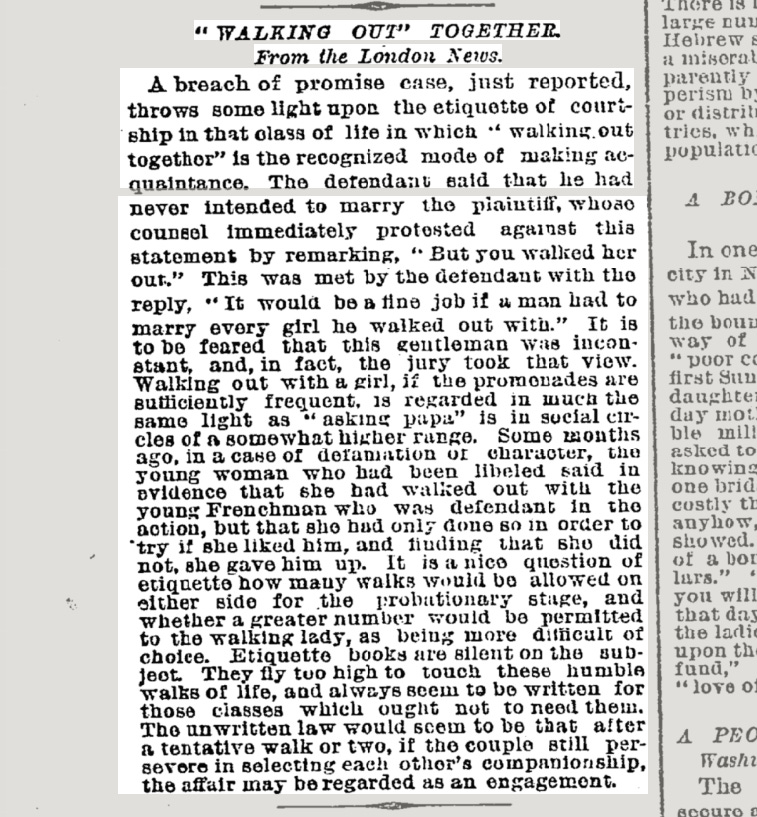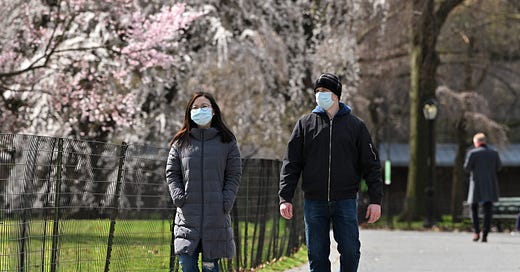
Walking Out: How the Coronavirus Has Changed Socializing
As restaurants remain closed, walking dates make a comeback.
The coronavirus shutdowns have caused people to look for safe ways to connect with each other. Ironically, some of these ways have involved reversion to an older way of socializing—one not based on the conspicuous consumption entailed in going to restaurants and bars. Instead, we are talking and establishing connections together-apart through simply walking. This enterprise is free. It is another instance of the de-commercialization of the public space since quarantine measures have been imposed.
With a visit to someone’s apartment probably involving a risky sojourn in the lobby and elevator, the social walk is an attractive alternative. It sounds trendy but it's ripped from the pages of Jane Austen.
I am not joining the chorus of praise for solitary walking—for one thing, I could hardly hope to add anything fresh to the copious and distinguished literary genre established by Charles Baudelaire in 1863. Read Thoreau for the solitary walk in nature and Thomas De Quincey for the solitary walk in a city. In fact, this is the perfect time to dive into the more contemporary but still philosophical treatment in Rebecca Solnit’s Wanderlust. But I am interested in the way the walking date involves you in a shared enterprise, however small, so it builds intimacy more in an organic way.
As events were canceled and numerous New York establishments were closed, Mel Magazine reported on the rise of walking dates in the city: “People are more open, vulnerable and emotionally available than ever before, and though no one is happy about the state of the world, the novel coronavirus has made dating novel again, too. . . . going for a distanced stroll—though risky—has the potential to feel just right.”
Walking, you understand your friends more clearly. First of all, you can hear them since you’re not in a loud restaurant. (These days even Manhattan streets are quiet enough to have a well-heard conversation.) Second, there are fewer distractions. Because there’s no food involved, you’re focusing on the conversation, including body language and tone. Since you’re not drinking, your judgement remains unclouded.
You no longer have to worry about the typical traps and faux pas of wining-and-dining dates where the stakes and expectations run high. There is a New York type who always knows the most recherché restaurants, the hot new chef, the most bohemian outpost. That knowledge is temporarily worthless. Instead it’s cool to know where to walk, to know unusual neighborhoods to visit, obscure buildings to look at, the history of the city.
You can learn a lot about a person by what they notice and don’t notice and do and don’t do on a walk, maybe more than you learn by what people consume or don’t consume.
Of course this is another arena in which the economic and social disparities between the urban and rural environments across America are being thrown into stark relief. What I say here describes the urban New York City version, but with modifications it would apply to many smaller cities and to the suburbs I grew up in.
New York has an urban infrastructure unlike anywhere else in the United States, with many neighborhoods and streets intact from the early 19th century. By contrast, suburbs—due to poor planning and inaccessibility—tend to make it more difficult for their denizens seeking out the experience of walking that city-dwellers take for granted. The problem is acute enough that, in many locales, people have had to take matters into their own hands to press officials to make streets more walkable. Perhaps the post-pandemic world will take the need for accessible roads and public spaces more seriously as a matter of public health.

The New York Times on “‘Walking Out’ Together,” May 17, 1888
The walking date is reminiscent of the kind of one-on-one or small-group peripatetic socializing that was well known to our ancestors, rich and poor alike.
You can find it in the popular culture of the 19th century American working class for whom “walking out” meant dating leading to an engagement, and in 18th- and 19th-century English novels. In both cases, being outside was a way to escape social surveillance. It was also one of the few types of socially acceptable exercise for women.
As Sally Palmer summarizes in Persuasions: The Jane Austen Journal:
In Pride and Prejudice the Bennet girls find that “a walk . . . was necessary to amuse their morning hours and furnish conversation for the evening.” Confronted with a walk in the rain to see her sister Jane at Netherfield, Elizabeth Bennet points out that “‘The distance is nothing, . . . only three miles’”; Persuasion’s Mary Musgrove protests that she is “‘very fond of a long walk’”; and the Dashwood sisters of Sense and Sensibility discover interesting sights a mile and a half from their cottage.
I hope that as commerce reopens in New York we can keep some of the perspective on dating and consuming and spending that the pandemic has forced upon us.










